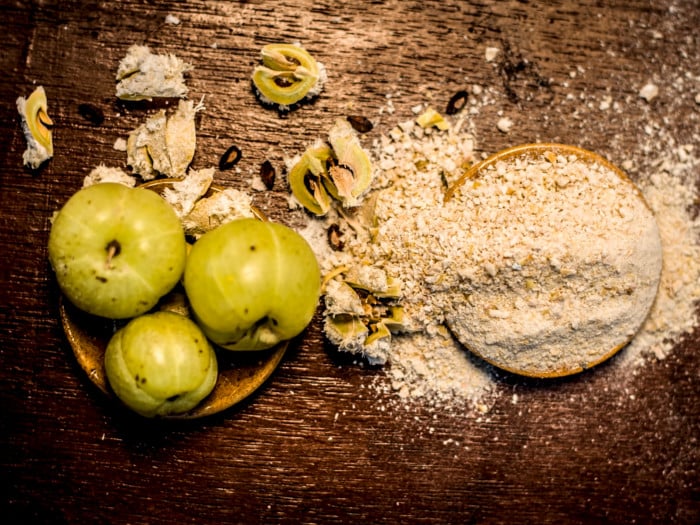Amla or Indian gooseberry is one of the most commonly used ingredients in Ayurveda. While the fruit may not be readily available in many parts of the world, amla powder today is more accessible. It provides one easy and readymade access to one of nature’s most potent gifts. Let’s take a look at how and why you should use it.
What is Amla Powder?
Amla powder is made from the dried amla, scientific name Emblica officinalis or Phyllanthus emblica. Amla is known for its antioxidant properties, which are also responsible for the many health benefits it offers. While the fruit is quite sour, the powder has a slightly bitter aftertaste. Amla powder is made by powdering the dried fruit. It can be made at home by sun-drying the fruit and then powdering it in a blender. You can know more about the fruit in our article Benefits of Eating Indian Gooseberry or Amla. Amla powder is used in hair care, skincare, can improve digestion, and help regulate blood sugar.
Amla Powder for Hair
Amla powder was traditionally used for hair care. You will find it in many Ayurvedic applications. It was most recommended as a hair tonic, which could slow down and even reverse the graying of hair. Although there is no conclusive research to support this belief, it is still used widely to pigment hair. Research shows that amla can not only protect hair health but also promote growth. Amla powder can be utilized in multiple ways in hair care, from amla oil to hair masks. [1]
Amla oil: Gently heat two tablespoons in a cup of coconut oil till it turns blackish-brown in color. Let it cool and apply to your hair. The rest of the oil can be stored in an airtight bottle.
Hair mask: Make a paste by adding water to the amla powder. It should be a slurry-like paste. You can also add a few tulsi leaves to this paste. Grind the tulsi leaves and add it along with its juice to the amla hair mask. Amla powder is also often used with two other Ayurvedic ingredients, reetha and shikakai for hair masks. This is believed to make the hair more lustrous.
As a pigment: Amla powder has a strong black color, which is often used as a pigment. However, it is quite mild and will fade in just one wash. This is why amla powder is mixed with henna which has a stronger pigment. A paste is made by adding water to a mix of amla powder and henna. Apply this to your hair and leave it for a couple of hours. Wash it off with water. Amla oil can also be applied regularly for similar results.

Amla powder is great for hair, skin, and a host of other benefits. Photo Credit: Shutterstock
Other Uses
Amla powder has many other benefits, from regulating blood sugar levels to improving digestion.
Immune Boosting Tonic
Amla is a powerhouse of antioxidants and contains several potent bio-compounds that include vitamin C and A, alkaloids, polyphenols, and flavonoids. Research shows that it has anti-bacterial and anti-inflammatory properties. You can take a teaspoon of amla powder with plain water. Some people prefer to take it with fruit juice to dilute the bitter taste. However, beware of any artificial sweeteners in the fruit juice. [2]
For Skincare
Amla is a powerful anti-aging ingredient that is used in many Ayurvedic skin formulations. A 2019 research published in Biotechnology and Applied Biochemistry showed that it can improve skin elasticity, help reduce wrinkles and age spots. You can make a face mask with the powder. Add a teaspoon of honey to a tablespoon of amla powder. Dilute it with a little water. Apply it on your face, rubbing it in a circular motion. Let it stay for 10-20 minutes. Wash it off with lukewarm water. [3]
To Improve Digestion
The high fiber content in amla helps in improving our digestive health. It is one of the most effective remedies for constipation. Amla powder helps the body to retain water, which helps with constipation and other digestive issues. Just dissolve a teaspoon of amla powder in water for a stomach-soothing drink! [4]
As a Blood Purifier
Amla has diuretic properties, which help in eliminating toxins from the body. This makes it useful as a blood purifier. Amla powder can be taken with honey or jaggery for the best effect. [5]
For Controlling Blood Sugar
Multiple researches have shown that amla could help in reducing blood sugar levels in people with diabetes. It has lipid-lowering and anti-hyperglycemic properties. This is why people with diabetes are recommended to take the fruit every day. You can use the amla powder for the same effect. Just mix a tablespoon in a glass of water and drink up. [6]
Where to Buy Amla Powder?
You are unlikely to find amla powder at your local grocery store. You may have better luck at health stores. Your best bet would be online where many vendors stock it and will ship it to your location. Do make sure that you are buying organic amla powder. This is all the more important when dealing with dried powdered fruits because you can be sure that it won’t contain any additives. If you are looking for amla powder-based skincare or haircare products, do check the labels for other additives.
Word of Caution
Amla powder is generally safe to use. But do make sure that you buy from an organic source to avoid any contaminants. Read the label to make sure there are no additives. It should not be used for medicinal purposes without a doctor’s advise. We also advise caution in case of pregnant and breastfeeding women. People with diabetes or those with a bleeding disorder should also exercise caution. It may interfere with their medication. Finally, we would advise moderation when ingesting amla powder.

